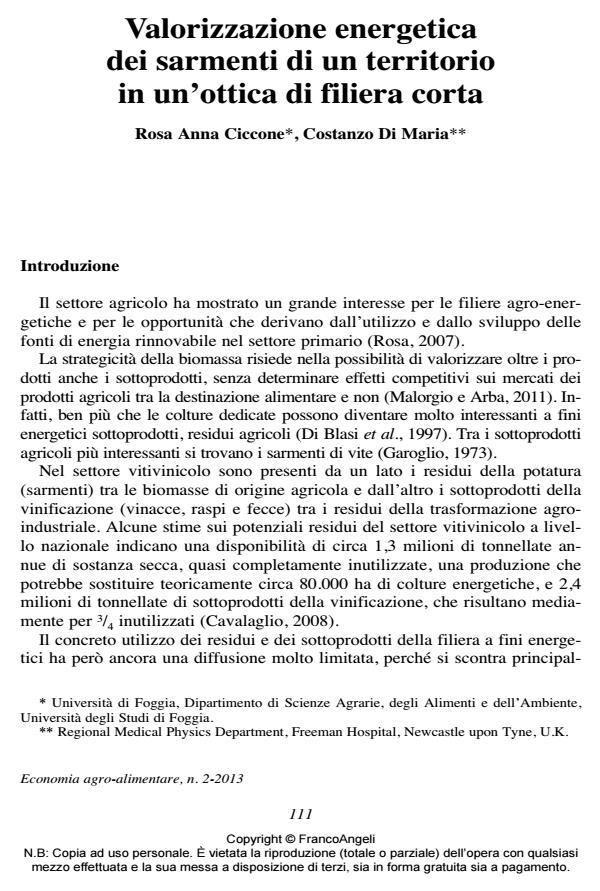Valorizzazione energetica dei sarmenti di un territorio in un’ottica di filiera corta
Journal title ECONOMIA AGRO-ALIMENTARE
Author/s Rosa Anna Ciccone, Costanzo Di Maria
Publishing Year 2013 Issue 2013/2
Language Italian Pages 16 P. 111-126 File size 195 KB
DOI 10.3280/ECAG2013-002007
DOI is like a bar code for intellectual property: to have more infomation
click here
Below, you can see the article first page
If you want to buy this article in PDF format, you can do it, following the instructions to buy download credits

FrancoAngeli is member of Publishers International Linking Association, Inc (PILA), a not-for-profit association which run the CrossRef service enabling links to and from online scholarly content.
The farming sector has been showing increasing interest in the possibility to setup bio-energetic chains and the benefits that can be obtained from the valorisation ofrenewable energy sources available in the primary sector (Rosa, 2007).Vine shoots produced during the vine trimming process usually represent aproblem for the farm since it needs to deal with and pay to dispose of them; the maincosts are related to the processes of shredding and burying. Those vine shoots caninstead be exploited and provide an additional income (Cotana et al., 2008).The process for the valorisation of the waste material deriving from the trimmingconsists in treating the residual agricultural biomass (trimmed shoots) by utilising theprocesses of shredding and drying. This allows obtaining a biofuel (chips or pellet) thatcan be used in the same farm to meet its energy demands (heating, cooling, electricity).From the Foggia area, an estimated 31,755 ha of vineyards can provide in total88,121 t of biomass per year. This gives the possibility to create in this area 7biomass power plants of variable size up to a limit of 1 MW.The exploitation of biomass from agroforestry sources to produce electric energycan provide an opportunity in terms of both energy availability and technologicaldevelopment. Moreover, it can revitalise the agricultural, forestry and zootechnicalactivities which represent one of the main components of the local economy inPuglia and help with the preservation of the territory. In this study, a method hasbeen developed to estimate the energy production that can be obtained from thebiomass available in a certain territory. The planning has been optimised on the basisof the number, size, location, and the basin of interest of the plants. The valorisationof the biomass deriving from the viticulture sector can provide and distribute benefitsthroughout the chain, making profit from what currently represent only an additionalcost for the farms. This argumentation demonstrates that supporting the entrance ofthe viticulture sector into the agrinergy world is of paramount importance.
Keywords: Vine shoots, short supply chain
Jel codes: Q24, Q42
Rosa Anna Ciccone, Costanzo Di Maria, Valorizzazione energetica dei sarmenti di un territorio in un’ottica di filiera corta in "ECONOMIA AGRO-ALIMENTARE" 2/2013, pp 111-126, DOI: 10.3280/ECAG2013-002007